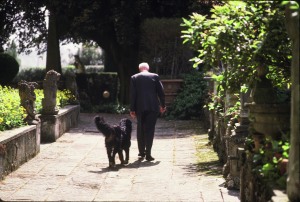“Today, when visitors first encounter the charm and elegance of Tuscan villas and gardens, they see what they want to see—Renaissance beauty—not recognizing that they are admiring is the work of a 20th-century English architect. In 1986, I was one of these starry-eyed admirers, gazing out over the Florentine landscape in awe and ignorance, which was about to be remedied. It was my first visit, made in the mold of The Grand Tour, but rather than travel with a retinue in a horse-drawn carriage, I was with my husband and 6-year-old son in the family Volkswagen. It was a self-guided tour to improve and expand my knowledge of garden history; I arrived in Florence, clutching my copy of Georgina Masson’s 1959 classic, Italian Gardens, with Edith Wharton’s Italian Villas and their Gardens written in 1903, as back-up, and managed to visit the highpoints. Villa Gamberaia, with its garden plan a perfect progression from light to dark, rustic to classical, left me speechless—and at my first sight of its famous water parterre I burst into tears. At the Villa Medici at Fiesole I became curious to learn more about the history of Italian gardens, because from its tiny giardino segreto, (secret garden), a true relic of the Renaissance, I caught a glimpse of another, even more charming garden, which I later learned was Villa Le Balze, and one of Pinsent’s earliest Florentine gardens.
That visit laid the foundations for my book The Gardens of Tuscany[1], and introduced me to Sir Harold Acton. We met in the salon of his home, Villa La Pietra. He sat in a rather dilapidated wing chair that was covered in faded silk damask. I perched on an armchair into which, in a more relaxed frame of mind, I might easily have slouched. Sir Harold was graciousness personified. I was tongue-tied. But then, serendipitously I mentioned that I was originally from Park Forest, Illinois. “But my mother was from Evanston!” he exclaimed. “I used to visit there regularly as a child, and adored Marshall Fields.” So, two expatriates found common ground, exchanging reminiscences about the Walnut Room (what would he think about Macy’s takeover and the loss of the Marshall Fields moniker, a byword for quality? He’d probably be as saddened and incredulous as I was).
During the interview, Sir Harold described how his father, Arthur Acton, designed garden surrounding the villa to be a showcase for his parent’s immense collection of classical sculpture and talked of garden design in Tuscany during the late Edwardian period. He mentioned that his father had consulted Cecil Pinsent about the addition of a small garden building at La Pietra, a project that was never pursued. Pinsent, he explained, was the architect of many of the villas and landscapes built by the Anglo-American expatriate community, which included some of the most notable members of the expatriate literati in Florence, and that these villas and gardens are today among the most admired in Tuscany. Sir Harold brought his palms together as if in prayer and resting his chin on delicately poised fingertips fixed me with a steady gaze. “You know,” he said, “You really ought to find out everything you can about Pinsent. So little about him is known with any accuracy.” You hold in your hands the results, to date, of that bit of advice. When someone of Sir Harold’s stature makes a suggestion, you’re well advised to listen.”
Excerpted from the introduction to my soon-to-be published book (by W. W. Norton), which has been in the works for at least six years, but I have an excuse since I did bring out a new edition of ‘Hidcote: the Making of a Garden’ and take on a full-time position as the Editor in Chief of Organic Gardening magazine, published by Rodale, Inc. and the first publication to introduce organic practices to American gardeners, some 70 years ago.
You also read about Cecil Pinsent’s Tuscan Villas and Gardens in “Cecil Pinsent and his gardens in Tuscany” papers from the symposium, Georgetown University, Villa Le Balze, Fiesole, 22 June 1995, which is the first place my biography of Pinsent and a thorough examination of his life and work was published by me, Giorgio Galletti, Vincent Shacklock and others.
